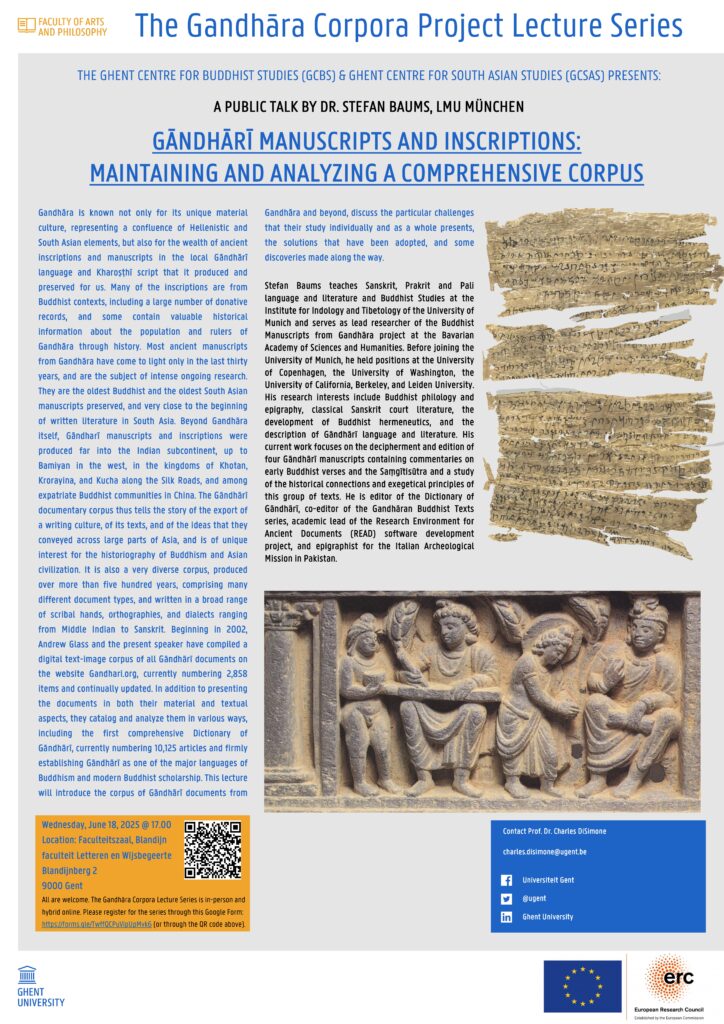We are thrilled to share that the third lecture in our ongoing “Gandhāra Corpora Project Lecture Series” will be delivered by Dr. Stefan Baums from the University of Munich! The lecture series is organized by Prof. Charles DiSimone, leader of the ERC-funded project “Corpora in Greater Gandhāra: Tracing the development of Buddhist textuality and Gilgit/Bamiyan manuscript networks in the first millennium CE” at the Ghent Centre for Buddhist Studies.
Title: GĀNDHĀRĪ MANUSCRIPTS AND INSCRIPTIONS: MAINTAINING AND ANALYZING A COMPREHENSIVE CORPUS
Speaker: Stefan Baums, University of Munich
Timing: Wednesday, June 18, 2025 @17.00
Location: Faculteitszaal, Blandijn faculteit Letteren en Wijsbegeerte (Blandijnberg 2, 9000 Gent) In-person and ONLINE
All are welcome. Please register for the series through this Google Form: https://forms.gle/TwffQCPuVipUpMvk6
Abstract:
Gandhāra is known not only for its unique material culture, representing a confluence of Hellenistic and South Asian elements, but also for the wealth of ancient inscriptions and manuscripts in the local Gāndhārī language and Kharoṣṭhī script that it produced and preserved for us. Many of the inscriptions are from Buddhist contexts, including a large number of donative records, and some contain valuable historical information about the population and rulers of Gandhāra through history. Most ancient manuscripts from Gandhāra have come to light only in the last thirty years, and are the subject of intense ongoing research. They are the oldest Buddhist and the oldest South Asian manuscripts preserved, and very close to the beginning of written literature in South Asia. Beyond Gandhāra itself, Gāndharī manuscripts and inscriptions were produced far into the Indian subcontinent, up to Bamiyan in the west, in the kingdoms of Khotan, Krorayina, and Kucha along the Silk Roads, and among expatriate Buddhist communities in China. The Gāndhārī documentary corpus thus tells the story of the export of a writing culture, of its texts, and of the ideas that they conveyed across large parts of Asia, and is of unique interest for the historiography of Buddhism and Asian civilization. It is also a very diverse corpus, produced over more than five hundred years, comprising many different document types, and written in a broad range of scribal hands, orthographies, and dialects ranging from Middle Indian to Sanskrit. Beginning in 2002, Andrew Glass and the present speaker have been compiling a text-image corpus of all Gāndhārī documents on the website Gandhari.org, currently numbering 2,858 items and continually updated. In addition to presenting the documents in both their material and textual aspects, they catalog and analyze them in various ways, including the a dictionary of the Gāndhārī language, currently numbering 10,125 articles and firmly establishing Gāndhārī as one of the major languages of Buddhism and modern Buddhist scholarship. This lecture will introduce the corpus of Gāndhārī documents from Gandhāra and beyond, discuss the particular challenges that their study individually and as a whole presents, the solutions that have been adopted, and some discoveries made along the way.
Bio:
Stefan Baums teaches at the Institute for Indology and Tibetology of the University of Munich and serves as lead researcher of the Buddhist Manuscripts from Gandhāra project at the Bavarian Academy of Sciences and Humanities. Before joining the University of Munich, he held positions at the University of Copenhagen, the University of Washington, the University of California, Berkeley, and Leiden University. His research interests include Buddhist philology and epigraphy, classical Sanskrit court literature, the development of Buddhist hermeneutics, and the description of Gāndhārī language and literature. His current work focuses on the decipherment and edition of four Gāndhārī manuscripts containing commentaries on early Buddhist verses and the Saṃgītisūtra and a study of the historical connections and exegetical principles of this group of texts. He is editor of the Dictionary of Gāndhārī, co-editor of the Gandhāran Buddhist Texts series, academic lead of the Research Environment for Ancient Documents (READ) software development project, and epigraphist for the Italian Archeological Mission in Pakistan.
